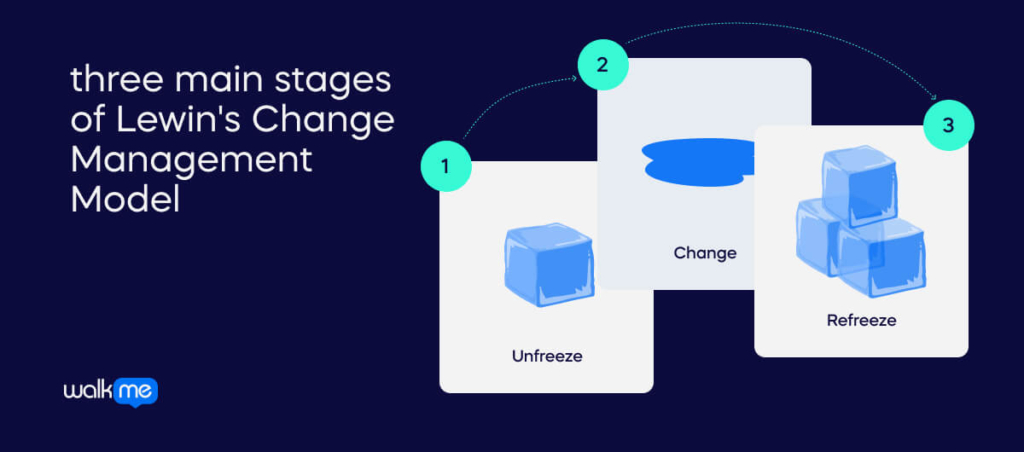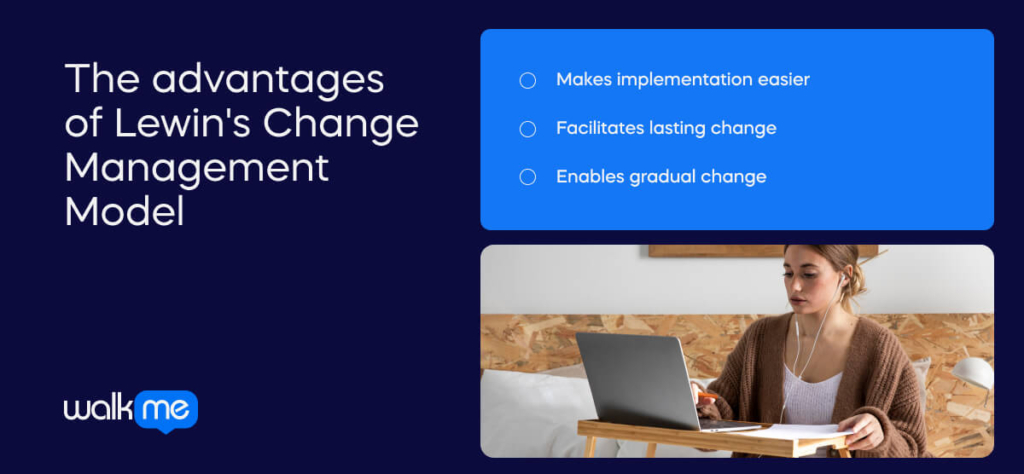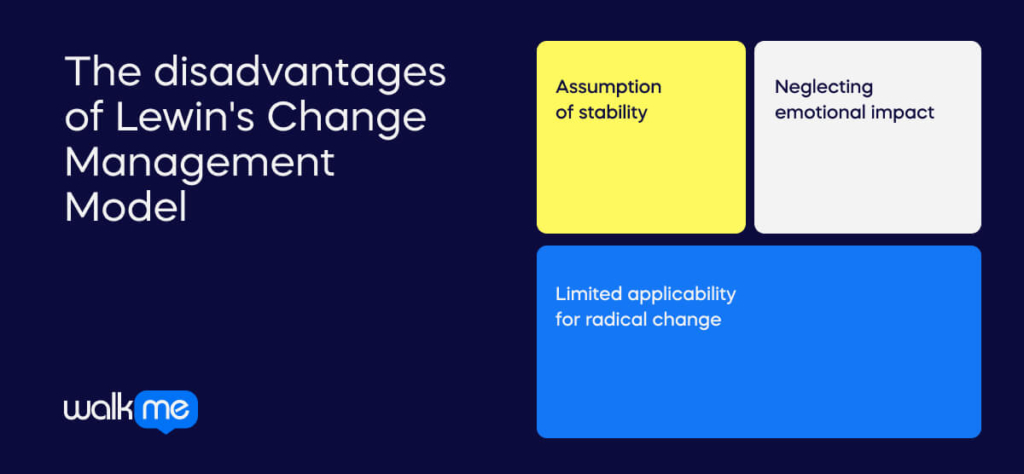In today’s rapidly changing business world, embracing workplace transformation is critical for organizations to succeed.
While potentially intimidating, change is essential; avoiding it can lead to failure. Organizations must be adept at managing shifts, whether adapting to industry changes or integrating new leadership.
Effective change management strategies are crucial for navigating these transitions and achieving the desired outcomes. Kurt Lewin’s Change Management Model from the 1940s is notable in this domain.
This model simplifies the change process into three steps: Unfreeze, Change, and Refreeze. Lewin likened this process to reshaping a block of ice, illustrating how organizations can effectively implement change.
By the end of this article, you will understand:
- What Lewin’s Change Management Model is
- The origins of Lewin’s Change Management Model
- The three main stages of Lewin’s Change Management Theory
- The advantages and disadvantages of Lewin’s Change Management Model
- Use cases for Lewin’s Change Theory within the workplace
What is Lewin’s Change Management Model?
Lewin’s Change Management Model offers a thorough framework for understanding and implementing change effectively.
Kurt Lewin’s Change Management Model identifies two types of forces that impact the behavior of groups and individuals during change: driving forces and restraining forces.
Driving forces motivate and guide employees toward embracing new changes. Restraining forces represent resistance to change, posing significant barriers to change initiatives.
Lewin emphasizes the importance of balancing these forces for successful change management. One can achieve this balance through effective communication, ensuring employees are part of the change process, and providing necessary training to address skill gaps.
Additionally, change agents should focus on implementing stress management techniques, ensuring compliance with new processes or policies, and presenting convincing reasons for the change. This approach helps manage the motivation for and resistance to change, facilitating a smoother transition.
The model is structured around three phases: unfreezing, changing, and refreezing.
Successful navigation through all three phases indicates an effective change management process.
What are the origins of Lewin’s Change Management Model?
A pioneering psychologist, Lewin believed in resolving social conflicts to improve the human condition. He emphasized learning as a tool for individuals to reshape their understanding of the world, drawing on Gestalt psychology influences.
His work integrated concepts of Field Theory, Group Dynamics, Action Research, and a 3-Step change model as a unified approach to facilitate change at various levels.
Field Theory focuses on mapping forces in a group’s environment to understand and induce behavior change. Group Dynamics stresses the importance of group behavior and interactions in the change process.
Action Research combines action with a thorough analysis of situations to enable effective change, emphasizing the need for a genuine desire for change within the group.
Lewin’s theories, initially declining in interest after his death, have regained relevance, particularly in understanding complex organizational dynamics and change management.
His integrated approach remains a cornerstone in studying group behavior and guiding organizational change processes.
What are the three main stages of Lewin’s Change Management Model?

Lewin described organizational change through the metaphor of reshaping a block of ice. Imagine you have a large ice cube but need it to be a cone. The process involves three steps: melt the cube to make it malleable (unfreeze).
Next, mold the liquid ice into the desired cone shape (change). Finally, freeze it again to solidify the new form (refreeze). This analogy illustrates the organizational change process in a simple and relatable way.
Let’s examine each stage of Lewin’s change model in more detail to better understand it. Understanding the necessity for change is paramount to initiating a successful change process.
This understanding marks the beginning of the “unfreeze” stage, the first phase in Lewin’s model:
Stage 1 – Unfreeze
This stage involves managing perceptions to prepare stakeholders for impending organizational change. Change leaders should foster a readiness for change and create a sense of urgency, akin to Kotter’s change model.
Key activities in this unfreezing stage include conducting business process analysis to identify current inefficiencies, securing organizational buy-in, crafting a strategic change vision, communicating compellingly about the need for change, and transparently addressing employee concerns.
Effective communication is crucial to gain team member support and buy-in.
Stage 2 – Change
This stage focuses on implementing the change as the status quo is disrupted. For a smoother transition, it is beneficial to adopt an agile, iterative approach that includes employee feedback.
Key actions include maintaining open communication to support your team, organizing change management workshops, empowering employees to embrace change proactively, and achieving quick wins to motivate the team.
Stage 3 – Refreeze
In the final stage, employees transition from change to stabilization or acceptance. However, if change leaders don’t reinforce the new ways in the organizational culture, there’s a risk of reverting to old behaviors.
To support lasting change, recognize and reward early adopters and change champions, solicit regular employee feedback, provide ongoing training and support, and consider using digital adoption platforms to spearhead change.
These platforms offer features like interactive walkthroughs and customizable pop-ups to facilitate change.
What are the advantages of Lewin’s Change Management Model?

There are several compelling benefits of applying Lewin’s Change Management Model:
Makes implementation easier
Organizational change management varies greatly in success, influenced by the nature of the business, the scope of the change, and the personnel involved. A key aspect is how well everyone grasps the change process from beginning to end.
Lewin’s theory, with its straightforward three-step model, simplifies implementation. The transition from the Unfreeze to the Change phase is designed to make change more digestible for new hires and long-term employees, whose collective acceptance is crucial for the success of any organizational transformation.
Facilitates lasting change
Corporate transformations often struggle with longevity and effectiveness. Rapid, poorly planned changes can lead to adverse outcomes, as in specific high-profile corporate examples. Lewin’s model, particularly the Unfreeze stage, allows for a significant transition period.
This phase helps people overcome resistance to change and gradually embrace transformation. It also allows leaders to thoughtfully consider their objectives and adapt their strategies to ensure success.
Enables gradual change
Lewin’s theory advocates for gradual, intentional change, always focusing on the long-term benefits of the transformation. The concept of the Unfreeze step is crucial here: the more people understand and feel the urgency of the change, the more motivated they become to embrace it.
This understanding builds momentum that is essential for successful transformation. This momentum, generated by a deep awareness of the need for change, is vital to moving smoothly through the process and achieving lasting results.
What are the disadvantages of Lewin’s Change Management Model?

Assumption of stability
Lewin’s model assumes organizations operate in stable environments, allowing for a smooth transition between the “unfreeze,” “change,” and “refreeze” stages. However, modern businesses often face volatile conditions due to geopolitical, financial, regulatory, and security challenges. This dynamic reality can disrupt the linear progression the model suggests.
Neglecting emotional impact
Employee resistance and uncertainty are common challenges in any change initiative. While Lewin’s model acknowledges the need to “unfreeze” existing mindsets, it may not fully address employees’ emotional responses and potential influence on the change process. A more nuanced approach that considers the human element of change might be necessary.
Limited applicability for radical change
The unfreeze-change-refreeze model may be too simplistic for organizations undergoing radical or transformational change. This type of change often requires a more flexible and adaptive approach than the structured, plan-driven model Lewin proposes. A framework that emphasizes agility and iterative adjustments might be more suitable in such cases.
Practical use cases of Lewin’s Change Management Model within the workplace
Lewin’s change model, with its unfreeze-change-refreeze stages, has proven to be a timeless and valuable framework for organizations changing.

Here are some practical examples of how you can apply Lewin’s 3-stage model within your business:
Modifying workforce behavior and skills
Change initiatives often necessitate behavioral changes and ongoing skill development among employees. Continuous training is vital until the change becomes a natural part of their workflow, allowing employees to assume greater responsibilities effectively.
Altering organizational processes, structures, and systems
A successful change initiative must thoughtfully modify business processes, structures, and systems. If innovation is not adequately balanced with process efficiencies, it could lead to increased operational costs and reduced service speed.
Transforming organizational culture
Organizations with robust cultures can achieve up to three times the shareholder returns. Embedding change initiatives into the organizational culture is essential for long-term benefits.
Implementing new technology
Successful technology adoption requires creating urgency, evaluating current systems, preparing for change, implementing new technology, and ensuring sustainability.
This systematic approach reduces the risk of failure, facilitates a smoother transition, and maximizes the benefits of new technological investments.
Revamping products or services
When altering products or services, swift action, thorough evaluation of existing offerings, crafting a new strategy, and integrating these changes into the company’s culture and processes are crucial.
In this context, adhering to Lewin’s model can minimize the risk of failure, ensure effective implementation, and help achieve the intended outcomes.
Driving successful change using Lewin’s Change Management Model
Lewin’s Change Management Model suggests that the effectiveness of organizational change hinges on the extent to which the organization’s members comprehend the rationale behind the change, the methodology of its execution, and their expected roles and responsibilities following the implementation of the change.
Implementing Lewin’s Change Theory can be a gradual process within an organization.
When applying this theory, start small, laying a foundational strategy that involves easy-to-achieve short-term goals. This approach helps build consensus and acceptance across the company.
Employees often observe management and leadership’s reactions to gauge the acceptance of change at different organizational levels.
Engaging in open conversations with employees is essential to understanding their needs, concerns, and apprehensions when progressing from the unfreeze to the change stage.
A clear vision for change should be articulated. Regular updates to all stakeholders and staff involved in the change process are crucial, aiming to eliminate secrecy or lack of transparency.
Adapting to new methods may be challenging for some employees, who might find the change process daunting or uncomfortable. Staying attuned to any negative sentiments among staff and promptly addressing any issues or misconceptions is essential.
Keeping communication channels open is vital. As you approach the refreeze stage, where change becomes the new norm, employees will appreciate any information you provide.
Perhaps the most crucial aspect is maintaining a positive outlook. According to Lewin’s model, being an early adopter of the changes yourself sets a strong example.
Offering frequent personal feedback to employees can boost their confidence and help establish expectations for enduring change.


